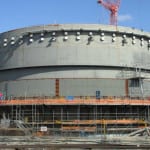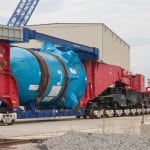Delays and other contested costs are expected to push the price for two new units being constructed at the V.C. Summer Nuclear Generating Station up by $980 million, a petition freshly filed by South Carolina Electric & Gas Co. (SCE&G) with the Public Service Commission of South Carolina (SCPSC) shows.
SCE&G made the filing to obtain approval from the SCPSC for construction milestone schedule and capital cost schedule updates for the two new units being added to the site near Jenkinsville, S.C. The new construction schedule extends substantial completion dates out to June 19, 2019, for Unit 2, and to June 16, 2020, for Unit 3. The cost increase pushes the new total for the two units up to about $9.45 billion from its original estimate of $8.18 billion (all costs are calculated in 2007 dollars).
SCE&G owns 55% of the new units, while Santee Cooper holds a 45% stake in the expansion. However, the ownership split will change when the first new unit enters commercial operation.
On Jan. 27, 2014, Santee Cooper announced that SCE&G agreed to acquire an additional 5% ownership interest in the two new nuclear units—a process that will take place in three stages. Under the agreement, 1% will be acquired from Santee Cooper at the commercial operation date of the first unit, an additional 2% will be acquired no later than the first anniversary of the first unit’s commercial operation date, and the final 2% will be acquired no later than the second anniversary of the same commercial operation date.
The petition SCE&G filed on March 12 was required because several project milestone dates have exceeded the allowable contingency time periods previously approved by the SCPSC. SCE&G said in a statement that it hasn’t waived any claims related to the delay and other related contested costs with the construction consortium comprising Westinghouse Electric Co. and Chicago Bridge & Iron. It also said the schedule does not reflect all mitigating strategies that could be pursued.
“We are not pleased with the delays in the construction schedule for our new nuclear plants. These delays and related cost increases are principally due to design and fabrication issues associated with the production of submodules used in construction of the units,” Kevin Marsh, chairman and CEO of SCANA Corp. (SCE&G’s parent company), said in the press release.
However, substantial progress has been made toward the completion of the units, according to the petition. Eighty-five percent of the major equipment for Unit 2 has been received onsite. Eighty-six percent of the circulating water system for both units has been installed. Two of four cooling towers are complete and the third is 67% finished.
The containment vessel bottom heads of both units have been fabricated and set on nuclear island basemats. All three of the steel rings that comprise the vertical walls of the Unit 2 containment vessel have been completed or are nearing completion. Ring 1 has been set in place on Unit 2. Fabrication is in progress on Rings 1 and 2 for Unit 3.
Staffing for the units is well underway, with 66 personnel in training to become licensed system operators and 84 personnel in training as non-licensed operators or for technical, maintenance, and craft positions. More than 3,800 construction personnel are currently working at the site.
The increased capital costs resulting from the delays has been somewhat negated by savings in other areas. SCE&G noted that inflation and interest rates have been significantly lower than originally anticipated. The company also said that because fewer new nuclear projects are being pursued in the U.S., fuel cost reductions should be realized through the application of production tax credits, based on current construction schedules and tax law. All told, SCE&G says the savings from these factors could total $2.6 billion in benefits realized by ratepayers.
“We remain firmly committed to completing these plants that will bring clean, safe, and reliable electricity to meet the long-term energy needs of South Carolina,” Marsh said.
—Aaron Larson, associate editor (@AaronL_Power, @POWERmagazine)










